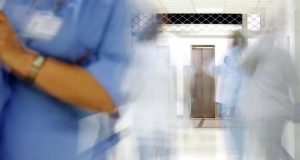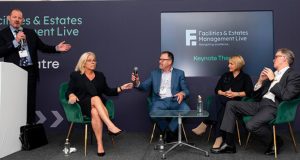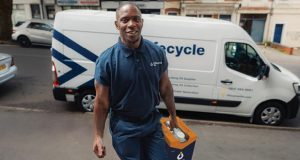THIRD SPACES
The growth of activity-based working is a tacit recognition that people need to work alongside each other and so refutes the idea that the office is dying. The reason we can be confident that people will always want to work together in physical spaces is tied up in human nature, which remains relatively fixed, however much other variables change.
One of the key areas of research that describes the role and importance of this enduring need for proximity is the work of Tom Allen of MIT. Allen made his name in 1984 with the publication of a book called Managing the Flow of Technology, which first presented the Allen curve showing a powerful negative correlation between physical distance and frequency of communication between colleagues.
This is the basis for the ongoing need for us to work in offices, albeit in new ways. People are now free to work in hotels, cafés, public spaces, airport lounges, coworking offices and at home. Inevitably, we are seeing a convergence in the form and function of all these types of buildings. So, just as hotels are beginning to take on some of the characteristics of offices, so too are office designers co-opting lounges, cafés and courtyards from hotels into their activity-based working models. The office isn’t dying. It’s cross-pollinating.
There has always been an element of this, notably in the way the most iconic furniture designs are not the sole preserve of any particular type of building. The seating designs of Charles and Ray Eames, Arne Jacobsen, Ludwig Mies van der Rohe and others defy this sort of categorisation precisely because they are human focused and work in any sort of physical surroundings.
These are the ageless symbols of the new world of work, and so it is not surprising that a new generation of seating products is building on this legacy. One firm that typifies this is Steelcase, whose new Learning and Innovation Centre in Munich openly displays this convergence of design idioms.
THE NEED TO MOVE
Underlying all of this is the need for us to move, and not just for the sake of finding the right space. Research cited in the Diabetologia medical journal found that the average adult in the western world now spends between 50 and 60 per cent of their time in what it calls ‘sedentary pursuits’. Although the journal is most concerned with diabetes, which it claims is the illness most consistently associated with a sedentary life, it also identifies the myriad other conditions which are linked to excessive sitting. These include cardiovascular disease alongside a range of musculoskeletal disorders, depression, obesity and circulatory and pulmonary ailments.
So what can be done, especially for those whose work demands a large time spent sitting? The first thing, of course, is to ensure that we are looking after ourselves properly when we are sedentary. This not only means buying the right sorts of seating, furniture (including sit-stand desks) and so on, but also remaining aware of posture, the way we use technology, movement and all the other factors that ensure we can not only avoid harm but actually foster our wellness.
The second thing we can do comes free. Get up, take a break and go for a walk. Not only will this help to alleviate the physical consequences of prolonged sitting, it can also help to alleviate fatigue and depression, is likely to give your eyes a rest if you’ve spent too long working at a computer screen, and – if you walk outside – gives you the chance to soak up some daylight.
Researchers at Stanford even found that a walk can help to foster creativity. They found that walking indoors or outdoors can boost creativity by 60 per cent. The act of walking itself, and not the environment, is the main factor because subjects showed that even walking on a treadmill elicited many of the same benefits as a walk in the park.
One of the most interesting additional findings of the research is that walking is not necessarily a great way to focus on a specific task – it allows our minds to take a little wander themselves. This is no bad thing, as anybody who has had a great idea while taking a shower will know. Sometimes the breakthroughs come while we have breakouts.




